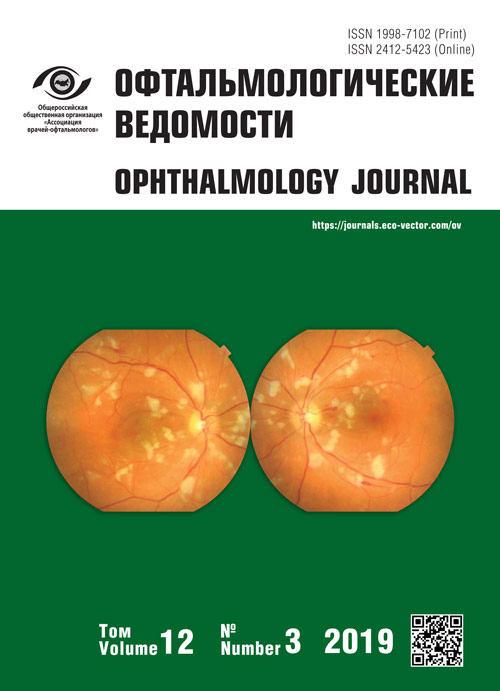脉 络膜视网膜病变误诊的原因之一——局灶性钙化
- 作者: Stoyukhina A.S.1
-
隶属关系:
- Research Institute of Eye Diseases
- 期: 卷 12, 编号 3 (2019)
- 页面: 31-39
- 栏目: Original study articles
- ##submission.dateSubmitted##: 02.09.2019
- ##submission.dateAccepted##: 20.09.2019
- ##submission.datePublished##: 16.12.2019
- URL: https://journals.eco-vector.com/ov/article/view/15931
- DOI: https://doi.org/10.17816/OV15931
- ID: 15931
如何引用文章
详细
视网膜及脉络膜局灶性钙化往往见于常见肿瘤,如视网膜母细胞瘤、脉络膜骨瘤、脉络膜血管瘤和视网膜星形细胞瘤。此外,还存在特发性或继发性钙化,其中巩膜脉络膜钙化最为常见。本文详细分析了成年患者骨化的临床情况及断层影像。结果表明,除了检眼镜检查结果不同,骨化的特征还包括病理性钙化灶位置的不同和视网膜损伤程度的不同。
全文:
视网膜及脉络膜局灶性钙化往往见于常见肿瘤,如视网膜母细胞瘤(RB)、脉络膜骨瘤(CO)、脉络膜血管瘤(CH)和视网膜星形细胞瘤(RA)。此外,还存在特发性或继发性钙化,其中巩膜脉络膜钙化(SCC)最为常见。
这些疾病应主要当与黑色素瘤和脉络膜转移灶鉴别 [1-3],但在临床实践中,这些潜在变化通常被视为由脉络膜视网膜复合体炎性过程引起,进而导致患者治疗不当。
CO、巩膜脉络膜钙化和RA的诊断最为困难。遗憾的是,作为眼内肿瘤诊断“金标准”的超声检查(US),对于这些临床疾病获得的信息十分有限。CO、SCC和RA在超声回波图上一般表现为脉络膜视网膜复合体区高反射灶面积扩大,形成声影现象 [4–7],而CH和RB表现为肿瘤组织点状强回声包涵物 [7-9]。
脉络膜骨瘤(骨迷离瘤)是一种罕见的良性肿瘤,表现为脉络膜成熟骨组织形成 [10, 11]。虽然目前文献报道了4个月早产儿 [12]和68岁患者[13]的CO病例,但该病主要见于二三十岁的女性 [4, 5]。
由于CO生长缓慢,视觉障碍的发展往往十分缓慢。在31%至47%的病例中,骨瘤因视网膜下新生血管膜(SNM)的形成造成视力下降 [2, 5, 14]。
通过形态学研究在脉络膜毛细血管层及外层间可见细胞型骨组织,表现为被扩张的薄壁血管穿透的骨小梁 [10, 11]。
经检眼镜检查发现,CO位于黄斑区或视乳头旁区,主要表现为纯黄色或橙色结节,边界清,表面不均 [4, 5, 14, 15]。结节表面常见网状血管丛 [2, 5],66%至80%的病例为单侧病变 [5, 15]。然而,目前有文献指出,在随访期间CO开始见于对侧眼 [16],或受累眼出现了第二个病灶 [17]。
超声检查证实,随访以及治疗(激光凝固术和光动力疗法)[2, 4, 5]后CO可能出现自发脱钙,导致视网膜色素上皮(RPE)和脉络膜毛细血管萎缩 [4, 5]。光学相干断层成像(OCT)检查证明,导致视力下降的SNM,见于钙化和脱钙部位边缘 [2, 14]。抗VEGF药(用于治疗SNM)玻璃体内给药后,有时会发生RPE破裂,也可造成视力明显下降 [18]。
巩膜脉络膜钙化是一种罕见的脉络膜及巩膜良性钙化。在大多数病例(79%)中,这一过程为特发性。此外,SCC也会见于遗传性肾小管病(如Bartter综合征和Gitelman综合征)、慢性肾衰竭、Albright遗传性骨营养不良,并发导致高血钙症和低镁血症的疾病,如甲状旁腺功能亢进、假性甲状旁腺功能减退症、维生素D中毒、结节病或低磷血症 [19-22]。SCC最常见于47岁至88岁的白人女性 [19, 21, 23]。近半数病例为双眼发病 [19, 23, 24]。但也有可能出现多灶性病变 [23]。即便是多灶性SCC视力预后也较好,这因为主要发病部位是颞上血管弓,视网膜中央凹陷区结构依然完整 [19, 25]。这与附着的上斜肌部位持续受力有关 [19, 20]。此外,SCC在检眼镜检查中表现为轻微隆起性黄色病变,呈新月形,边界清,表面不均,表面可见RPE萎缩区。
视网膜星形细胞错构瘤(星形细胞瘤)是一种良性神经胶质肿瘤,多发于视网膜神经纤维层。多为偶然发现,主要见于年轻患者,既往报道了散发性(29%)及综合征相关性RA病例 [26]。综合征相关性RA通常是结节性硬化症的临床表现之一 [26-28]。此外,视网膜星形细胞错构瘤可并发色素性视网膜炎、神经纤维瘤病或神经鞘瘤 [26, 27]。RA通常无症状;但包括黄斑区单独脱落在内的继发性渗出性视网膜脱落,可导致眼内出血、新生血管性青光眼、视觉损伤 [27, 28]。
星形细胞瘤主要位于眼底中央区。既往报道了两种星形细胞瘤——非钙化和钙化 [1, 28],两者也可能并发 [28]。
钙化性星形细胞瘤在检眼镜检查中表现为界限清晰的白色或黄白色结节,受表面囊肿影响可呈桑葚形 [9, 28]。裂隙灯及诊断镜眼底显微镜检查提示该病与点状亮白色钙化区有关 [9]。
对于大多数病例,根据检眼镜检查具体分析结果,可准确诊断局部脉络膜视网膜钙化。但在某些疑难病例中,视网膜OCT能够为诊断提供重要帮助。然而,目前研究仅仅详细描述了个例情况。研究人员已尝试根据特异性OCT特征对多种脉络膜和视网膜肿瘤进行分类,方便临床鉴别诊断 [29]。然而,既往研究没有分析这些有助于正确诊断视网膜及脉络膜局部钙化的特异性体征,因而并未提出有效的治疗方法。
因此,本研究旨在分析CO、SCC和RA患者的OCT研究结果。
材料和方法
研究对象包括10例患者(SCC 5例,CO 3例,RA 2例)。
根据现有操作规范进行检眼镜检查,以标准模式和增强深度成像(EDI)模式进行OCT检查(OCT Spectralis,海德堡工程,德国)。光相干断层扫描图像用灰色模式进行分析,但病灶的直径通过OCT眼底红外像测量。
此外,我们采用了IBM SPSS Statistics 23.0软件对获得的结果进行统计学分析。
结果和讨论
SCC患者(5例患者,6只眼)的年龄在59岁至73岁不等(平均年龄为68.0 ± 2.78岁)。在双眼多灶性病变病例(1例)(图1)中,据另一门诊的医疗文件记载,双眼外周中部可见“萎缩性”病灶。超声检查提示这一特征表现为强回声区扩大,伴有声影现象,被视为脉络膜视网膜炎的转归。另一方面,在其余病例中,该病灶系偶然发现(4例患者,4只眼)。
图1 72岁双眼多灶性巩膜脉络膜钙化患者B.的右眼(a)和左眼(b)眼底照片
受累眼的最高矫正视力(MCVA)与对侧眼几乎相同(平均值分别为0.73 ± 0.17和0.83 ± 0.09)(p = 0.28)。1例病例的受累眼MCVA降低了0.07,由并发的Ⅳ期青光眼所致。在其他病例中,视力降低0.8,由与年龄有关的晶状体改变所致。
病灶通常距离视网膜中心凹3.22 ± 0.39mm,边界清,边缘黄白色。此外,经检眼镜检查,病灶中央部分可见视网膜萎缩体征。病灶通常为椭圆形(5个病灶)或新月形(4个病灶),直径几乎相等(分别为5.66 ± 0.54mm和5.98 ± 0.57mm)。对于多灶性病变,一个病灶呈圆形(直径2.3mm),两个病灶形状不规则,最大直径分别为11.5mm和12.5mm。这说明病灶的形状反映了病程持续时间。
对于单灶病变病例(4只眼),病灶位于颞上血管弓。
1例患者首次就诊3年后眼底出现第2个病灶(图2)。应当注意的是,该例患者的跟腱同时出现钙化。
图2 59岁患者Sh.首次就诊(a) 和38个月后随访时(b) 的眼底照片(绿色箭头——第一个病灶边缘,蓝色箭头——第二个病灶边缘)
3例女性患者的年龄分别为59、72和73岁,有全身性疾病病史,即其血液生化分析改变提示矿物质代谢紊乱、软组织(肌肉和肌腱)钙化沉积,而72岁患者还被诊断为双眼多灶性眼疾。此外,上述73岁患者患有多发性自发性骨折。其余两例病例(男,分别为64岁和69岁)的血液生化分析未见异常。
在本研究病例中,SCC的OCT特征是:脉络膜视网膜隆起,表面不均,呈结节状,Bruch膜轮廓呈“峰形”,脉络膜变薄伴信号高反射增强,Bruch膜可见受损区,视网膜结构异常(因视网膜Bruch膜“峰形”区外层萎缩而变薄,Bruch膜收缩区核层扩大导致视网膜增厚)(图3、图4)。在变薄的脉络膜下方,可见局部中度低反射区(图5),考虑其为巩膜内层病变的特异性体征 [3]。此外,在视网膜病变区,无法观察到脉络膜外缘。
图3 72岁患者B.光学相干断层成像。巩膜脉络膜钙化水平扫描。绿色箭头——Bruch膜“钉状”外形,蓝色箭头——Bruch膜“陷阱”区
图4 64岁患者T.光学相干断层成像。经巩膜脉络膜钙化下侧 水平扫描。箭头——视网膜损伤区,可见下层脉络膜外缘损伤
图5 59岁患者Sh.光学相干断层成像。巩膜脉络膜钙化水平扫描。箭头——严重 变薄的脉络膜和Bruch膜“陷阱”区;虚线——变薄脉络膜下方的低反射结构
所有CO患者(3例,4只眼)的病变部位位于眼底中央区(近视乳头靠鼻侧,从下部起延伸至中心凹;近视乳头,从颞侧起,未累及黄斑区)。
两例患者由于视力下降(因黄斑区SNM形成分别下降0.1和0.03)前往门诊就诊。1例22岁,1例35岁,分别有双眼病变和单眼病变。双眼病变患者(图6)的对侧眼MCVA为1.0。该例患者起初因亚急性中央性脉络膜视网膜炎住院治疗,在过去10年内发现右眼视力逐步下降。在他前往眼科疾病研究所(Research Institute of Eye Diseases)就诊的6个月前,视力突然下降,在眼科疾病研究所诊断为因此开具治疗SNM的抗VEGF药物,仅玻璃体内给药。
图6 22岁双眼脉络膜骨瘤患者G.的右眼(a)和左眼(b)眼底照片。箭头——脉络膜新生血管形成
另一例(图7)35岁女性患者在常规产检时经诊断发现眼底“斑点”。分娩后次日,患者发现视力下降。前往眼科疾病研究所就诊6个月前,该患者在另一诊所行荧光血管造影,被诊断为视乳头周围脉络膜新生血管形成,为此接受了三次抗VEGF药玻璃体
图7 35岁患者N.眼底照片。箭头——脉络膜新生血管形成
此外,偶然发现1例21岁患者有小病灶。该患者MCVA为1.0,检眼镜检查提示病灶下缘钙化(图8)。
图8 21岁患者Ch.眼底照片。箭头——病灶下缘钙化
在所有病例中,OCT检查时脉络膜外缘清晰可见。发现两种断层成像特征,均可见大病灶。
- 在脉络膜外层和强反射线水平存在脉络膜复合体隆起,呈网状结构,强反射线将肿瘤与严重变薄但结构完整的脉络膜分离开来,在RPE水平可见单一局部强反射灶(图9)。这些部位符合钙化性CO特征 [5, 30]。
图9 35岁患者N.光学相干断层成像。视乳头周围区域环形扫描。绿色箭头——区分脉络膜骨瘤与变薄脉络膜的高反射线;橙色箭头——可见Bruch膜受损区;星形符号——具有“网状结构”的脉络膜;红色箭头——脉络膜严重变薄区。眼底照片——图7
- 存在脉络膜隆起部位中度强反射区,脉络膜复合体结构呈片状,位于上部的视网膜未发生改变,这些符合脱钙性CO特征(图10)[30, 31]。CO脱钙也导致脉络膜萎缩(图9)[30]。
图10 22岁患者G左眼光学相干断层成像;视网膜中央凹水平扫描。箭头——脉络膜骨瘤和正常脉络膜之间的边界。眼底照片——图6b
此外,经OCT血管造影证实,上述病变边缘有SNM形成(图11、图12)。
图11 35岁患者N.左眼光学相干断层成像;脉络膜新生血管形成区水平扫描。蓝色星形符号——具有“网状结构”的脉络膜;绿色箭头——区分脉络膜骨瘤与变薄脉络膜的高反射线;红色星形符号——具有“片状”结构的脉络膜
图12 同一只眼的OCT血管造影,视网膜无血管层图像。箭头——脉络膜新生血管形成区
小病灶未见脉络膜复合体隆起;但其结构变化符合钙化性CO特征,RPE局部改变符合眼底钙化特征(图13)。此外,经超声检查也确认存在钙化区。
图13 21岁患者Ch.光学相干断层成像。脉络膜骨瘤垂直扫描。星形符号——具有“片状”结构的脉络膜,箭头——视网膜色素上皮水平局部改变。眼底照片——图8
视网膜星形细胞瘤(2例患者,2只眼):两例患者受累眼的MCVA均为1.0。1例76岁患者的RA位于颞侧外周中部。而1例32岁患者的RA位于黄斑旁。
上述两例RA病例均为偶然发现。
在检眼镜检查中,RA表现为黄白色隆起灶,表面呈结节状(桑葚形),边界清。76岁患者病灶周围出现视网膜大面积萎缩(图14)。
图14 76岁患者D.眼底照片。蓝色箭头——视网膜萎缩区,绿色箭头——星形细胞瘤
OCT视网膜内层增厚主要见于灶缘和神经纤维层。此外,病灶中央可见表面不均、边缘清晰的大腔及其明显高反射壁,大腔呈桑葚形。腔内同时可见大量高反射包涵物,病灶区的脉络膜厚度与外周区域无异。然而,鉴于局部筛查结果和伪影表现(图15),无法评估其结构,这与超声检查的混响效应相似。
图15 光学相干断层成像——视网膜星形细胞瘤最高隆起处水平扫描。星形符号——病灶中心腔;红色箭头——灶缘视网膜内层增厚;绿色箭头——下层结构局部保护区
OCT表现以及检眼镜检查结果,有助于对这些患者进行RA诊断。
结论
罕见的眼内膜局部钙化,往往病因各异,损伤程度也不同。原则上,可根据患者病史和检眼镜检查影像详细分析结果作出正确诊断。
但在一些疑难病例中,超声检查往往提示强回声灶,同时出现声影效应,在这种情况下OCT检查对于确诊至关重要,因为OCT能够明确眼内膜钙化损伤的程度。
可通过上颞血管弓定位过程进行SCC鉴别诊断(检眼镜检查结果),根据OCT检查结果,具体部位为脉络膜视网膜复合体隆起,伴有脉络膜变薄和Bruch膜“峰形”轮廓。我们认为,检出的变化与既往建议相符,即这一病变主要位于巩膜[19]。这也能解释仅脉络膜完全缺失部位发生视网膜改变的原因。
CO通常位于眼底中央区。典型的OCT体征包括脉络膜复合体扩大,复合体Bruch膜表面均匀,脉络膜结构紊乱(出现“网状”或“片状”结构)。与SCC相似,CO视网膜损伤见于病程后期。
最后,与上述疾病相反,RA病理过程往往位于视网膜内层。虽然脉络膜结构依然完整,但视网膜明显改变(视网膜内层增厚,存在表面不均、边界清晰、有明显高反射壁的大腔,腔内可见大量高反射包涵物)大大提高了观察的难度,反过来阻碍了下层组织的信号。
因此,将裂隙灯及诊断镜眼底显微镜检查与OCT结果对比,可以进行准确诊断,有助于制定治疗计划,从而能实现对患者的高效管理。
本文不存在利益冲突。
作者简介
Alevtina Stoyukhina
Research Institute of Eye Diseases
编辑信件的主要联系方式.
Email: a.stoyukhina@ya.ru
ORCID iD: 0000-0002-4517-0324
PhD, Senior Research Associate of Department of Retina and Optical Nerve Patology. Ophthalmology Department
俄罗斯联邦, 119021, Moscow, Rossolimo St., 11 A,B参考
- Мякошина Е.Б. Астроцитарная гамартома сетчатки: два клинических случая, визуализация с помощью спектральной оптической когерентной томографии // Российская педиатрическая офтальмология. – 2013. – № 1. – С. 23–27. [Myakoshina EB. Retinal astrocytic harmatoma: two clinical cases, visualization with the help spectral optical coherent tomography. Russian pediatric ophtalmology. 2013;(1):23-27. (In Russ.)]
- Alameddine RM, Mansour AM, Kahtani E. Review of choroidal osteomas. Middle East Afr J Ophthalmol. 2014;21(3):244-250. https://doi.org/10.4103/0974-9233.134686.
- Rao RC, Choudhry N, Gragoudas ES. Enhanced depth imaging spectral-domain optical coherence tomography findings in sclerochoroidal calcification. Retina. 2012;32(6):1226-1227. https://doi.org/10.1097/IAE.0b013e3182576e50.
- Trimble SN, Schatz H. Decalcification of a choroidal osteoma. Br J Ophthalmol. 1991;75(1):61-3. https://doi.org/10.1136/bjo.75.1.61.
- Chen J, Lee L, Gass JD. Choroidal osteoma: evidence of progression and decalcification over 20 years. Clin Exp Optom. 2006;89(2): 90-94. https://doi.org/10.1111/j.1444-0938.2006.00012.x.
- Semenova E, Veronese C, Ciardella A, et al. Multimodality imaging of retinal astrocytoma. Eur J Ophthalmol. 2015;25(6):559-564. https://doi.org/10.5301/ejo.5000627.
- Turell ME, Hayden BC, McMahon JT, et al. Uveal schwannoma surgery. Ophthalmology. 2009;116(1):163-163. https://doi.org/ 10.1016/j.ophtha.2008.08.045.
- Brennan RC, Wilson MW, Kaste S, et al. US and MRI of pediatric ocular masses with histopathological correlation. Pediatr Radiol. 2012;42(6):738-749. https://doi.org/10.1007/s00247-012-2374-6.
- Бровкина А.Ф., и др. Офтальмоонкология: руководство для врачей / под ред. А.Ф. Бровкиной. – М.: Медицина, 2002. – 420 с. [Brovkina AF, et al. Ophthalmooncologiya: rukovodstvo dlya vracey. Ed. by A.F. Brovkina. Moscow: Medicina; 2002. 420 р. (In Russ.)]
- Williams AT, Font RL, Van Dyk HJ, Riekhof FT. Osseous choristoma of the choroid simulating a choroidal melanoma. Association with a positive 32P test. Arch Ophthalmol. 1978;96(10):1874-7187. https://doi.org/10.1001/archopht.1978.03910060378017.
- Bessho H, Imai H, Azumi A. The histopathological finding of the surgically extracted atypical dome-shaped choroidal osteoma. Case Rep Ophthalmol Med. 2017;2017:2874823. https://doi.org/10.1155/2017/2874823.
- Aksoy Y, Çakir Y, Sevinçli S, et al. Choroidal osteoma in a preterm infant. Indian J Ophthalmol. 2018;66(4):583-585. https://doi.org/10.4103/ijo.IJO_914_17.
- Cennamo G, Romano MR, Iovino C, et al. OCT angiography in choroidal neovascularization secondary to choroidal osteoma. Acta Ophthalmol. 2017;95(2): e152-e154. https://doi.org/10.1111/aos.13142.
- Shields CL, Sun H, Demirci H, Shields JA. Factors predictive of tumor growth, tumor decalcification, choroidal neovascularization, and visual outcome in 74 eyes with choroidal osteoma. Arch Ophthalmol. 2005;123(12):1658-1666. https://doi.org/10.1001/archopht.123.12.1658.
- MirNaghi M, Nasser S, SeyedehMaryam H1, Ali S. Bilateral multifocal choroidal osteoma with choroidal neovascularization. Case Rep Ophthalmol Med. 2015;2015:346415. https://doi.org/10.1155/2015/346415.
- Aylward GW, Chang TS, Pautler SE, Gass JD. A long-term follow-up of choroidal osteoma. Arch Ophthalmol. 1998;116(10):1337-41. https://doi.org/10.1001/archopht.116.10.1337.
- Sambricio J, Fernández-Reyes M, De-Lucas-Viejo B, et al. A second new choroidal osteoma in the same eye: differences between them with new imaging techniques. Case Rep Ophthalmol Med. 2015;2015:684956. https://doi.org/10.1155/2015/684956.
- Erol MK, Coban DT, Ceran BB, Bulut M. Retinal pigment epithelium tear formation following intravitreal ranibizumab injection in choroidal neovascularization secondary to choroidal osteoma. Cutan Ocul Toxicol. 2014;33(3):259-263. https://doi.org/10.3109/15569527.2013.844702.
- Wong CM, Kawasaki BS. Idiopathic sclerochoroidal calcification. Optom Vis Sci. 2014;91(2):e32-37. https://doi.org/10.1097/OPX.0000000000000125.
- Cooke CA, McAvoy C, Best R. Idiopathic sclerochoroidal calcification. Br J Ophthalmol. 2003;87(2):245-246. https://doi.org/10.1136/bjo.87.2.245.
- Lee H, Kumar P, Deane J. Sclerochoroidal calcification associated with Albright’s hereditary osteodystrophy. BMJ Case Rep. 2012;2012. pii: bcr0320126022. https://doi.org/10.1136/bcr-03-2012-6022.
- Gupta R, Hu V, Reynolds T, Harrison R. Sclerochoroidal calcification associated with Gitelman syndrome and calcium pyrophosphate dihydrate deposition. J Clin Pathol. 2005;58(12): 1334-1335. https://doi.org/10.1136/jcp.2005.027300.
- Honavar SG, Shields CL, Demirci H, Shields JA. Sclerochoroidal calcification: clinical manifestations and systemic associations. Arch Ophthalmol. 2001;119(6):833-840. https://doi.org/10.1001/archopht.119.6.833.
- Yohannan J, Channa R, Dibernardo CW, et al. Sclerochoroidal calcifications imaged using enhanced depth imaging optical coherence tomography. Ocul Immunol Inflamm. 2012;20(3):190-192. https://doi.org/10.3109/09273948.2012.670358.
- Dedes W, Schmid MK, Becht C. [Sclerochoroidal calcifications with vision-threatening choroidal neovascularisation. (In German)]. Klin Monbl Augenheilkd. 2008;225(5):473-475. https://doi.org/10.1055/s-2008-1027276.
- Pusateri A, Margo CE. Intraocular astrocytoma and its differential diagnosis. Arch Pathol Lab Med. 2014;138(9):1250-1254. https://doi.org/10.5858/arpa.2013-0448-RS.
- Bloom SM, Mahl CF. Photocoagulation for serous detachment of the macula secondary to retinal astrocytoma. Retina. 1991;11(4): 416-422. https://doi.org/10.1097/00006982-199111040-00009.
- Shields JA, Shields CL. Glial tumors of the retina. The 2009 king khaled memorial lecture. Saudi J Ophthalmol. 2009;23(3-4): 197-201. https://doi.org/10.1016/j.sjopt.2009.10.003.
- Shields CL, Pellegrini M, Ferenczy SR, Shields JA. Enhanced depth imaging optical coherence tomography of intraocular tumors: from placid to seasick to rock and rolling topography – the 2013 francesco orzalesi lecture. Retina. 2014;34(8):1495-1512. https://doi.org/10.1097/IAE.0000000000000288.
- Navajas EV, Costa RA, Calucci D, et al. Multimodal fundus imaging in choroidal osteoma. Am J Ophthalmol. 2012;153(5):890-895. https://doi.org/10.1016/j.ajo.2011.10.025.
- Hayashi Y, Mitamura Y, Egawa M, et al. Swept-source optical coherence tomographic findings of choroidal osteoma. Case Rep Ophthalmol. 2014;5(2):195-202. https://doi.org/ 10.1159/000365184.
补充文件






















